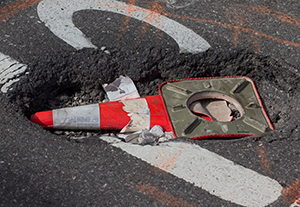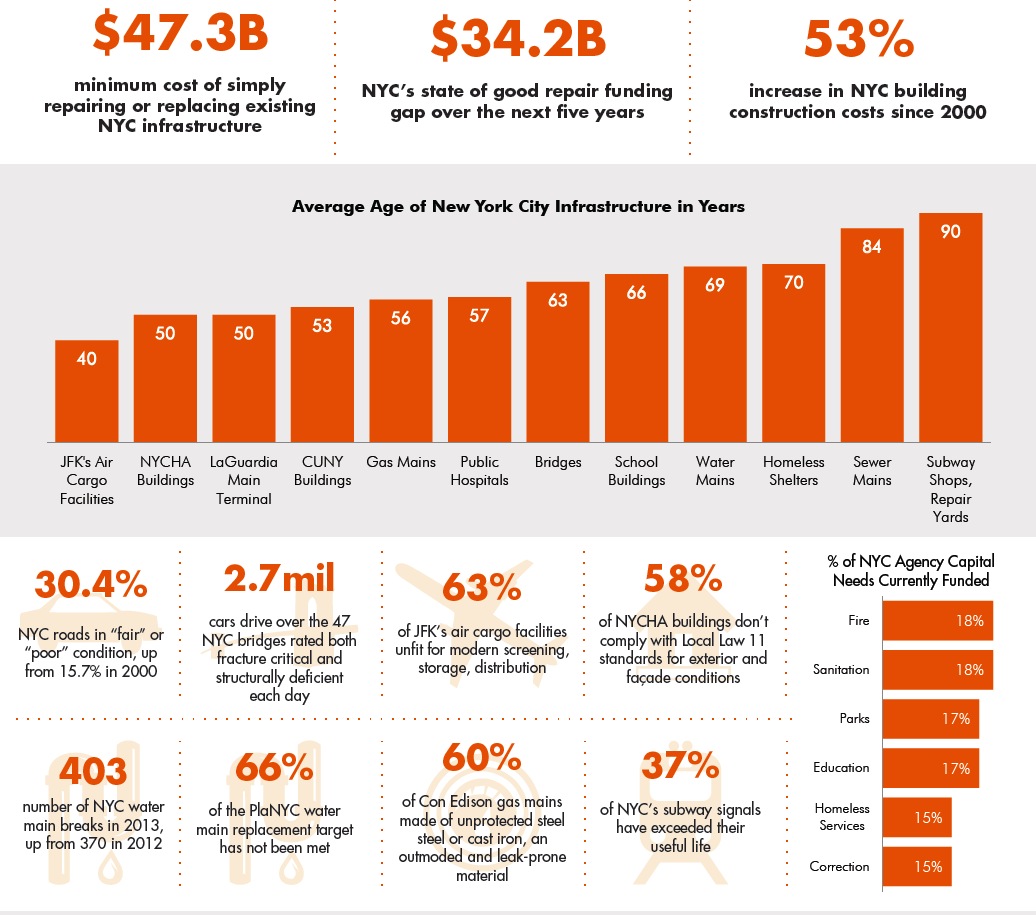CENTER FOR AN URBAN FUTURE
 FOLLOWING THE DEVASTATION OF SUPERSTORM SANDY IN OCTOBER 2012, NEW York City’s essential infrastructure needs were made a top policy priority for the first time in decades. The scale and severity of the storm prompted numerous studies to assess the damage and led policymakers to take steps to shore up the city’s coastal infrastructure weaknesses. Although that work remains imperative, New York City faces a number of other infrastructure vulnerabilities that have little to do with storm preparedness or resiliency. If left unchecked, they could wreak as much havoc on the city’s economy, competitiveness and quality of life as the next big storm.
FOLLOWING THE DEVASTATION OF SUPERSTORM SANDY IN OCTOBER 2012, NEW York City’s essential infrastructure needs were made a top policy priority for the first time in decades. The scale and severity of the storm prompted numerous studies to assess the damage and led policymakers to take steps to shore up the city’s coastal infrastructure weaknesses. Although that work remains imperative, New York City faces a number of other infrastructure vulnerabilities that have little to do with storm preparedness or resiliency. If left unchecked, they could wreak as much havoc on the city’s economy, competitiveness and quality of life as the next big storm.
New York City’s core infrastructure is in dramatically better shape than it was in the 1980s, when the city closed the Williamsburg Bridge for fear of collapse, track fires were a regular occurrence in the subway system and the Brooklyn Bridge, FDR Drive and West Side Highway all experienced structural failures. Yet, as we detail in this report, much of the city’s roads, bridges, subways, water mains, sewer systems, school buildings and other public buildings are more than 50 years old, and many critical components are past their useful life and highly susceptible to breaks and malfunctions.
Over 1,000 miles of New York City water mains are more than 100 years old, leading to frequent and disruptive breaks. More than 160 bridges across the five boroughs were built over a century ago, and in 2012 47 bridges were deemed both structurally deficient and fracture critical, a designation engineers use for bridges that have little structural redundancy, making them prone to failure and collapse. The subway’s aging signaling system—with 269 miles of mainline signals exceeding their 50-year useful life—slows the movement of trains and forces maintenance workers to build their own replacement parts because manufacturers no longer make them. Additionally, more than 200 of the city’s public school buildings were built before 1920.
Simply put, too much of the city’s essential infrastructure remains stuck in the 20th Century—a problem for a city positioning itself to compete with other global cities in today’s 21st Century economy.
While the Bloomberg administration increased capital spending significantly and made great strides on a number of important fronts, it put more emphasis on new construction than bringing older assets into a state of good repair. The city Department of Transportation (DOT) fell behind on street repaving, for instance, while the Department of Environmental Protection (DEP) lost ground on its own water main replacement targets—even as the city funded the first new water tunnel in nearly a century. Although the School Construction Authority dramatically increased the number of public school seats, the maintenance and repair of many older buildings suffered during this period.
This report finds that city agencies and authorities will have to invest approximately $47.3 billion to maintain the safety and functioning of New York’s infrastructure—leaving a $34.2 billion capital funding gap at the city, Port Authority, New York City Transit, Housing Authority and CUNY over the next five years. This funding gap includes only the replacement and repair of existing infrastructure—not new structures or increased capacity.
To remain a magnet for global businesses and talent, and to ensure the high quality of life current residents have come to expect, Mayor Bill de Blasio, Governor Andrew Cuomo and other government officials will need to make investing in the city’s aging infrastructure a major priority. Although it will not be easy in an era of diminished federal funds, this report outlines several achievable solutions for addressing New York’s critical infrastructure needs.
This report provides a comprehensive examination of New York City’s current infrastructure vulnerabilities. It goes beyond the coastal infrastructure challenges that were exposed after Super Storm Sandy and offers a new level of detail about the current state of the city’s infrastructure in a broad range of critical—but often neglected— areas, including roads and bridges, subways, airports, the electricity distribution system, natural gas service pipes, water mains, sewage pipes and the broadband network. Additionally, the report takes a close look at the state of New York’s civic infrastructure, including parks, schools, homeless shelters, CUNY facilities, public hospitals, libraries, public housing and courthouses. Based on extensive data analysis and interviews with more than 100 infrastructure experts in New York and around the nation, the report also puts forth a number of recommendations on what city and state officials can do to address the infrastructure deficiencies outlined in the report.

Download full version (PDF): Caution Ahead
About the Center for an Urban Future
nycfuture.org
The Center for an Urban Future is a NYC-based think tank dedicated to highlighting the critical opportunities and challenges facing New York and other cities, and providing fresh ideas and workable solutions to policymakers. The Center’s primary focus is on growing and diversifying the local economy, expanding economic opportunity and targeting problems facing low-income and working-class neighborhoods. We consistently elevate important, but long overlooked, issues onto the radar of public officials—and we push policymakers to think differently about economic and workforce development.
Tags: Center for an Urban Future, New York, New York City, NY, NYC, Superstorm Sandy






 RSS Feed
RSS Feed